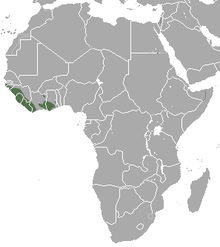- Sooty mangabey
-
Sooty mangabey [1] 
White-collared Mangabey (C. atys lunulatus) Conservation status Scientific classification Kingdom: Animalia Phylum: Chordata Class: Mammalia Order: Primates Family: Cercopithecidae Genus: Cercocebus Species: C. atys Binomial name Cercocebus atys
(Audebert, 1797)
Sooty Mangabey range The sooty mangabey (Cercocebus atys) is an Old World monkey found in forests from Senegal east to Ghana.[1] It is famous for being believed to be the monkey that HIV-2 might have originated in before jumping species. While overall rated as Vulnerable,[2] the eastern race lunulatus, also known as the white-crowned[3], white-naped[4] or white-collared mangabey (leading to easy confusion with the collared mangabey), is considered Endangered by the IUCN.[5]
Contents
Disease
It is believed that a strain of the Simian Immunodeficiency Virus (SIV) jumped from this species to humans to become the HIV-2 virus. The HIV-1 strain came from the common chimpanzee strain of SIV.[6][7]
The sooty mangabey can also contract leprosy, as can humans, the Nine-banded Armadillo, the common chimpanzee, and the crab-eating macaque.[8]
Habitat and ecology
The sooty mangabey lives in both old growth and secondary forests as well as in flooded, dry, swamp, mangrove, and gallery forests. The primate is arboreal and diurnal. They are omnivores whose diet includes primarily fruits and seeds, sometimes feeding on small animals. They live in social groups of four to twelve individuals, but occasionally groups as large as 95 individuals have been recorded.[9]
Taxonomy
There are two distinctive subspecies of this mangabey, and it is possible they should be considered separate species. Both were formerly considered subspecies of a widespread Cercocebus torquatus.[1]
- Cercocebus atys atys (west of the Sassandra River)
- White-collared (or White-crowned) mangabey, Cercocebus atys lunulatus (east of the Sassandra River)
References
- ^ a b c Groves, C. (2005). Wilson, D. E., & Reeder, D. M, eds. ed. Mammal Species of the World (3rd ed.). Baltimore: Johns Hopkins University Press. pp. 153. OCLC 62265494. ISBN 0-801-88221-4. http://www.bucknell.edu/msw3/browse.asp?id=12100427.
- ^ a b Oates, J. F., Gippoliti, S. & Groves, C. P. (2008). Cercocebus atys. In: IUCN 2008. IUCN Red List of Threatened Species. Downloaded on 4 January 2009.
- ^ White-crowned Mangabey. Mangabey Species Survival Plan. Accessed 2008-07-18
- ^ http://www.primate-sg.org/lunulatus.htm White-Naped Mangabey Cercocebus atys lunulatus. Accessed 2011-11-03
- ^ Oates, J. F., Gippoliti, S. & Groves, C. P. (2008). Cercocebus atys ssp. lunulatus. In: IUCN 2008. IUCN Red List of Threatened Species. Downloaded on 4 January 2009.
- ^ Binhua Ling, Cristian Apetrei, Ivona Pandrea, Ronald S. Veazey, Andrew A. Lackner, Bobby Gormus, and Preston A. Marx (August 2004). "Classic AIDS in a Sooty Mangabey after an 18-Year Natural Infection". J. Virol. 78 (16): 8902–8908. doi:10.1128/JVI.78.16.8902-8908.2004. PMC 479084. PMID 15280498. http://www.pubmedcentral.nih.gov/articlerender.fcgi?tool=pmcentrez&artid=479084.
- ^ Lemey, P.; Pybus, O. G.; Wang, B.; Saksena, N. K.; Salemi, M.; Vandamme, A. M. (2003). "Tracing the origin and history of the HIV-2 epidemic". Proceedings of the National Academy of Sciences 100 (11): 6588–6592. doi:10.1073/pnas.0936469100. PMC 164491. PMID 12743376. http://www.pubmedcentral.nih.gov/articlerender.fcgi?tool=pmcentrez&artid=164491.
- ^ Rojas-Espinosa O, Løvik M (2001). "Mycobacterium leprae and Mycobacterium lepraemurium infections in domestic and wild animals". Rev. Sci. Tech. Off. Int. Epiz. 20 (1): 219–51. PMID 11288514.
- ^ Rowe, N. (1996). The Pictorial Guide to the Living Primates. East Hampton, New York: Pogonias Press.
External links
- Sooty Mangabey
- Photos and information about the Sooty Mangabey (Cercocebus atys). ARKive.
- Primate Info Net Cercocebus atys Factsheet
This Old World monkey-related article is a stub. You can help Wikipedia by expanding it.

